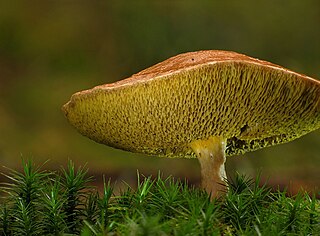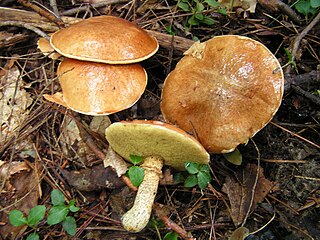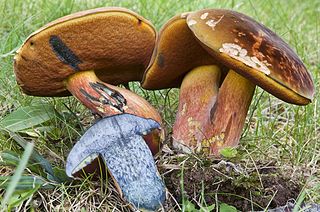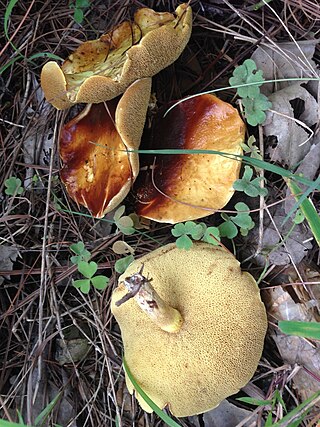
The Boletales are an order of Agaricomycetes containing over 1300 species with a diverse array of fruiting body types. The boletes are the best known members of this group, and until recently, the Boletales were thought to only contain boletes. The Boletales are now known to contain distinct groups of agarics, puffballs, and other fruiting-body types.

The Boletaceae are a family of mushroom-forming fungi, primarily characterised by small pores on the spore-bearing hymenial surface, instead of gills as are found in most agarics. Nearly as widely distributed as the agarics, the family is renowned for hosting some prime edible species highly sought after by mushroom hunters worldwide, such as the cep or king bolete . A number of rare or threatened species are also present in the family, that have become the focus of increasing conservation concerns. As a whole, the typical members of the family are commonly known as boletes.

Suillus is a genus of basidiomycete fungi in the family Suillaceae and order Boletales. Species in the genus are associated with trees in the pine family (Pinaceae), and are mostly distributed in temperate locations in the Northern Hemisphere, although some species have been introduced to the Southern Hemisphere.

Suillus luteus is a bolete fungus, and the type species of the genus Suillus. A common fungus native all across Eurasia from Ireland to Korea, it has been introduced widely elsewhere, including North and South America, southern Africa, Australia and New Zealand. Commonly referred to as slippery jack or sticky bun in English-speaking countries, its names refer to the brown cap, which is characteristically slimy in wet conditions. The fungus, initially described as Boletus luteus by Carl Linnaeus in 1753, is now classified in a different fungus family as well as genus. Suillus luteus is edible, though not as highly regarded as other bolete mushrooms. It is commonly prepared and eaten in soups, stews or fried dishes. The slime coating, however, may cause indigestion if not removed before eating. It is often sold as a dried mushroom.

Suillus bovinus, also known as the Jersey cow mushroom or bovine bolete, is a pored mushroom of the genus Suillus in the family Suillaceae. A common fungus native to Europe and Asia, it has been introduced to North America and Australia. It was initially described as Boletus bovinus by Carl Linnaeus in 1753, and given its current binomial name by Henri François Anne de Roussel in 1806. It is an edible mushroom, though not highly regarded.

Suillus variegatus, commonly called the velvet bolete or variegated bolete, is a species of edible mushroom in the genus Suillus. Like all bolete-like species it has tubes, and pores, instead of gills under its cap. The mushroom forms a mycorrhizal relationship with pine and occurs in North America and Eurasia.

Chalciporus is a genus of fungi in the family Boletaceae. There are approximately 25 species in the genus.

Bothia is a fungal genus in the family Boletaceae. A monotypic genus, it contains the single species Bothia castanella, a bolete mushroom first described scientifically in 1900 from collections made in New Jersey. Found in the eastern United States, Costa Rica, China, and Taiwan, it grows in a mycorrhizal association with oak trees. Its fruit body is chestnut brown, the cap is smooth and dry, and the underside of the cap has radially elongated tubes. The spore deposit is yellow-brown. The edibility of the mushroom is unknown. Historically, its unique combination of morphological features resulted in the transfer of B. castanella to six different Boletaceae genera. Molecular phylogenetic analysis, published in 2007, demonstrated that the species was genetically unique enough to warrant placement in its own genus.

Suillus americanus is a species of fungus in the mushroom family Suillaceae. Commonly known as the chicken fat mushroom, American suillus, it grows in a mycorrhizal association with eastern white pine and is found where this tree occurs in eastern North America and China. The mushroom can be recognized by the bright yellow cap with red to reddish-brown scales embedded in slime, the large yellow angular pores on the underside of the cap, and the narrow yellow stem marked with dark reddish dots. Molecular phylogenetics analysis suggests that S. americanus may be the same species as S. sibiricus, found in western North America and western and central Asia. Suillus americanus is edible, although opinions vary as to its palatability; some susceptible individuals may suffer a contact dermatitis after touching the fruit bodies. The fruit bodies contain a beta glucan carbohydrate shown in laboratory tests to have anti-inflammatory properties.

Suillus spraguei is a species of fungus in the family Suillaceae. It is known by a variety of common names, including the painted slipperycap, the painted suillus or the red and yellow suillus. Suillus spraguei has had a complex taxonomical history, and is also frequently referred to as Suillus pictus in the literature. The readily identifiable fruit bodies have caps that are dark red when fresh, dry to the touch, and covered with mats of hairs and scales that are separated by yellow cracks. On the underside of the cap are small, yellow, angular pores that become brownish as the mushroom ages. The stalk bears a grayish cottony ring, and is typically covered with soft hairs or scales.

Suillus sibiricus is a fungus of the genus Suillus in the family Suillaceae. It is found in mountains of Europe, North America, and Siberia, strictly associated with several species of pine tree. Due to its specific habitat and rarity in Europe, it has been selected for inclusion in several regional Red Lists. Its fruit bodies are characterised by having slimy caps in wet weather, which can reach diameters of up to 10 cm (3.9 in). On the underside of the cap are yellow angular pores that bruise a pinkish to cinnamon colour. The stem is up to 8 cm (3.1 in) tall and 2.5 cm (1.0 in) wide and typically has a ring, a remnant of the partial veil that covers the fruit body in its early development. In North America, it is commonly called the Siberian slippery jack. Phylogenetic analysis has shown that S. sibiricus is closely related to S. umbonatus and S. americanus, and may in fact be conspecific with the latter species.

Suillus placidus, is a species of fungus in the genus Suillus. It is an edible pored mushroom found in European and North American coniferous forests, growing in association with several species of pine of the subgenus Strobus.

Suillus intermedius is an edible species of mushroom in the genus Suillus. It is found in North America, Costa Blanca Mountains-Spain.
Suillus subalutaceus is an edible species of mushroom in the genus Suillus. It is found in North America and in Taiwan.

Suillus salmonicolor, commonly known as the Slippery Jill, is a fungus in the family Suillaceae of the order Boletales. First described as a member of the genus Boletus in 1874, the species acquired several synonyms, including Suillus pinorigidus and Suillus subluteus, before it was assigned its current binomial name in 1983. It has not been determined with certainty whether S. salmonicolor is distinct from the species S. cothurnatus, described by Rolf Singer in 1945. S. salmonicolor is a mycorrhizal fungus—meaning it forms a symbiotic association with the roots of plants such that both organisms benefit from the exchange of nutrients. This symbiosis occurs with various species of pine, and the fruit bodies of the fungus appear scattered or in groups on the ground near the trees. The fungus is found in North America, Hawaii, Asia, the Caribbean, South Africa, Australia and Central America. It has been introduced to several of those locations via transplanted trees.

Boletus subvelutipes, commonly known as the red-mouth bolete, is a bolete fungus in the family Boletaceae. It is found in Asia and North America, where it fruits on the ground in a mycorrhizal association with both deciduous and coniferous trees. Its fruit bodies (mushrooms) have a brown to reddish-brown cap, bright yellow cap flesh, and a stem covered by furfuraceous to punctate ornamentation and dark red hairs at the base. Its flesh instantly stains blue when cut, but slowly fades to white. The fruit bodies are poisonous, and produce symptoms of gastrointestinal distress if consumed.

Butyriboletus is a genus of fungi in the family Boletaceae. The genus was circumscribed in 2014 by mycologists David Arora and Jonathan L. Frank to accommodate "butter bolete" species that were shown by molecular analysis to be phylogenetically distinct from Boletus. Butyriboletus contains 24 ectomycorrhizal species found in Asia, Europe, North America and north Africa.

Suillus kunmingensis is a species of bolete fungus in the family Suillaceae. It was described as new to science in 1948 by Wei-Fan Chiu as a species of Boletinus; Wang and Yao transferred it to the genus Suillus in a 2004 nomenclatural revision of several Chinese boletes. The species epithet alludes to the type locality—Kunming, China—where the first scientific collections of the bolete were made in November, 1941. It has also been recorded from Sichuan. Similar Suillus species include S. pinetorum and S. punctatipes.

Suillus kaibabensis is a species of fungus in the family Boletaceae. The species was first described scientifically by American mycologist Harry D. Thiers.

















